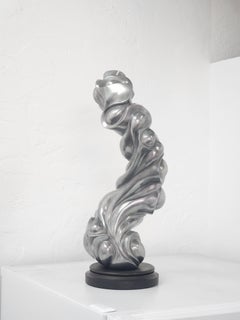Dick Wray Abstract Sculptures
Dick Wray was born at Heights Hospital in 1933 and primarily educated in Houston, Texas. He took free art lessons at the Houston Museum of Fine Arts in his early teens, graduated from Lamar High School (Houston, Texas) and, following military service in the U.S. Army from 1953 to 1955, enrolled in the School of Architecture of the University of Houston from 1955 to 1958. He finished his studies at the Kunstakademie Düsseldorf, Germany in 1959. Wray took off for Europe in 1958 to discover for himself the center of the art world, starting his journey in Paris. Wray’s first competitive show was at the Art Museum of Southeast Texas in Beaumont in 1959. In 1962 he was awarded the Ford Foundation Purchase Prize. Wray has had a number of solo exhibitions at the Contemporary Arts Museum in Houston and his works are continuing to be shown at William Reaves Gallery.
(Biography provided by Reeves Antiques)Mid-20th Century Abstract Dick Wray Abstract Sculptures
Metal
Mid-20th Century Abstract Dick Wray Abstract Sculptures
Metal
21st Century and Contemporary Abstract Dick Wray Abstract Sculptures
Steel
21st Century and Contemporary Abstract Dick Wray Abstract Sculptures
Metal
21st Century and Contemporary Abstract Dick Wray Abstract Sculptures
Metal
1980s Abstract Dick Wray Abstract Sculptures
Metal
2010s Abstract Dick Wray Abstract Sculptures
Wire
21st Century and Contemporary Abstract Dick Wray Abstract Sculptures
Metal, Brass
2010s Abstract Geometric Dick Wray Abstract Sculptures
Gold Leaf
Early 2000s Abstract Geometric Dick Wray Abstract Sculptures
Metal, Silver, Steel, Gold Leaf
1990s Abstract Geometric Dick Wray Abstract Sculptures
Metal
1960s Abstract Dick Wray Abstract Sculptures
Metal
1980s Abstract Expressionist Dick Wray Abstract Sculptures
Enamel, Bronze
2010s Abstract Dick Wray Abstract Sculptures
Wire
